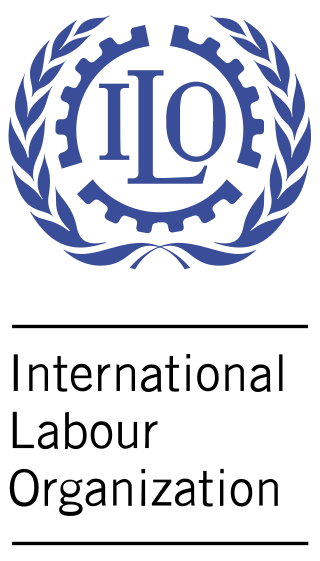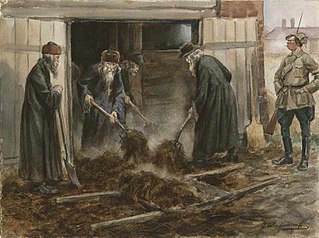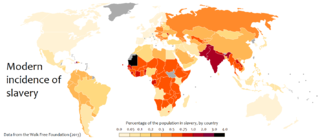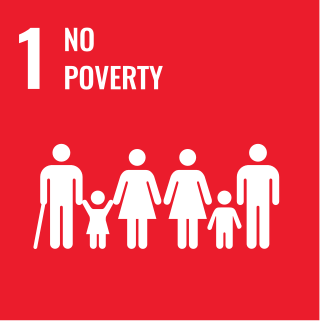Related Research Articles

The International Labour Organization (ILO) is a United Nations agency whose mandate is to advance social and economic justice by setting international labour standards. Founded in October 1919 under the League of Nations, it is one of the first and oldest specialised agencies of the UN. The ILO has 187 member states: 186 out of 193 UN member states plus the Cook Islands. It is headquartered in Geneva, Switzerland, with around 40 field offices around the world, and employs some 3,381 staff across 107 nations, of whom 1,698 work in technical cooperation programmes and projects.

Debt bondage, also known as debt slavery, bonded labour, or peonage, is the pledge of a person's services as security for the repayment for a debt or other obligation. Where the terms of the repayment are not clearly or reasonably stated, or where the debt is excessively large the person who holds the debt has thus some control over the laborer, whose freedom depends on the undefined or excessive debt repayment. The services required to repay the debt may be undefined, and the services' duration may be undefined, thus allowing the person supposedly owed the debt to demand services indefinitely. Debt bondage can be passed on from generation to generation.

Child labour is the exploitation of children through any form of work that interferes with their ability to attend regular school, or is mentally, physically, socially and morally harmful. Such exploitation is prohibited by legislation worldwide, although these laws do not consider all work by children as child labour; exceptions include work by child artists, family duties, supervised training, and some forms of work undertaken by Amish children, as well as by Indigenous children in the Americas.

Forced labour, or unfree labour, is any work relation, especially in modern or early modern history, in which people are employed against their will with the threat of destitution, detention, or violence, including death or other forms of extreme hardship to either themselves or members of their families.
Labor rights or workers' rights are both legal rights and human rights relating to labor relations between workers and employers. These rights are codified in national and international labor and employment law. In general, these rights influence working conditions in the relations of employment. One of the most prominent is the right to freedom of association, otherwise known as the right to organize. Workers organized in trade unions exercise the right to collective bargaining to improve working conditions.

Trafficking of children is a form of human trafficking and is defined by the United Nations as the "recruitment, transportation, transfer, harboring, and/or receipt" kidnapping of a child for the purpose of slavery, forced labour, and exploitation. This definition is substantially wider than the same document's definition of "trafficking in persons". Children may also be trafficked for adoption.

Child labour is a recurring issue in cocoa production. Cote d’Ivoire and Ghana, together produce nearly 60% of the world's cocoa each year. During the 2018/19 cocoa-growing season, research commissioned by the U.S. Department of Labor was conducted by NORC at the University of Chicago in these two countries and found that 1.48 million children are engaged in hazardous work on cocoa farms including working with sharp tools and agricultural chemicals and carrying heavy loads. That number of children is significant, representing 43 percent of all children living in agricultural households in cocoa growing areas. During the same period cocoa production in Cote d’Ivoire and Ghana increased 62 percent while the prevalence of child labour in cocoa production among all agricultural households increased 14 percentage points. Attention on this subject has focused on West Africa, which collectively supplies 69% of the world's cocoa, and Côte d'Ivoire, supplying 35%, in particular.
Child labour in Botswana is defined as the exploitation of children through any form of work which is harmful to their physical, mental, social and moral development. Child labour in Botswana is characterised by the type of forced work at an associated age, as a result of reasons such as poverty and household-resource allocations. Child labour in Botswana is not of higher percentage according to studies. The United States Department of Labor states that due to the gaps in the national frameworks, scarce economy, and lack of initiatives, “children in Botswana engage in the worst forms of child labour”. The International Labour Organization is a body of the United Nations which engages to develop labour policies and promote social justice issues. The International Labour Organization (ILO) in convention 138 states the minimum required age for employment to act as the method for "effective abolition of child labour" through establishing minimum age requirements and policies for countries when ratified. Botswana ratified the Minimum Age Convention in 1995, establishing a national policy allowing children at least fourteen-years old to work in specified conditions. Botswana further ratified the ILO's Worst Forms of Child Labour Convention, convention 182, in 2000.

Slavery has been called "deeply rooted" in the structure of the northwest African country of Mauritania and estimated to be "closely tied" to the ethnic composition of the country, although it has also been estimated that "Widespread slavery was traditional among ethnic groups of the largely nonpastoralist south, where it had no racial origins or overtones; masters and slaves alike were black", despite the cessation of slavery across other African countries and an official ban on the practice since 1905.

The continent of Africa is one of the regions most rife with contemporary slavery. Slavery in Africa has a long history, within Africa since before historical records, but intensifying with the trans-Saharan and Indian Ocean slave trade and again with the trans-Atlantic slave trade; the demand for slaves created an entire series of kingdoms which existed in a state of perpetual warfare in order to generate the prisoners of war necessary for the lucrative export of slaves. These patterns persisted into the colonial period during the late 19th and early 20th century. Although the colonial authorities attempted to suppress slavery from about 1900, this had very limited success, and after decolonization, slavery continues in many parts of Africa despite being technically illegal.

Contemporary slavery, also sometimes known as modern slavery or neo-slavery, refers to institutional slavery that continues to occur in present-day society. Estimates of the number of enslaved people today range from around 38 million to 49.6 million, depending on the method used to form the estimate and the definition of slavery being used. The estimated number of enslaved people is debated, as there is no universally agreed definition of modern slavery; those in slavery are often difficult to identify, and adequate statistics are often not available.

Human trafficking is the trade of humans for the purpose of forced labour, sexual slavery, or commercial sexual exploitation.
Human trafficking in Israel includes the trafficking of men and women into the country for forced labor and sex slavery. The country has made serious efforts to reduce the problem in recent years and now ranks 90th out of 167 countries who provide data. Identification of victims, criminal justice work and efforts to co-ordinate with business and government agencies has been concerted in reducing this problem in the last decade.

Debt bondage in India or Bandhua Mazdoori was legally abolished in 1976 but remains prevalent due to weak enforcement by the government. Bonded labour is a system in which lenders force their borrowers to repay loans through labor. Additionally, these debts often take a large amount of time to pay off and are unreasonably high, propagating a cycle of generational inequality. This is due to the typically high interest rates on the loans given out by employers. Although debt bondage is considered to be a voluntary form of labor, people are forced into this system by social situations.
Statistics on unemployment in India had traditionally been collected, compiled and disseminated once every ten years by the Ministry of Labour and Employment (MLE), primarily from sample studies conducted by the National Sample Survey Office. Other than these 5-year sample studies, India had historically not collected monthly, quarterly or yearly nationwide employment and unemployment statistics on a routine basis. In 2016, the Centre for Monitoring Indian Economy, a non-governmental entity based in Mumbai, started sampling and publishing monthly unemployment in India statistics.

Human trafficking in Southeast Asia has long been a problem for the area and is still prevalent today. It has been observed that as economies continue to grow, the demand for labor is at an all-time high in the industrial sector and the sex tourism sector. A mix of impoverished individuals and the desire for more wealth creates an environment for human traffickers to benefit in the Southeast Asia region. Many nations within the region have taken preventive measures to end human trafficking within their borders and punish traffickers operating there.

The Global Slavery Index is a global study of modern slavery published by the Minderoo Foundation's Walk Free initiative. Four editions have been published: in 2013, 2014, 2016 and 2018.
The Freedom Fund is an international non-profit organisation dedicated to identifying and investing in the most effective frontline efforts to end slavery. In 2017, the International Labour Organization reported that on any given day in 2016, there were 40 million people living in modern slavery worldwide across a wide range of industries.
Human Trafficking or "trafficking in persons" is the recruiting, harboring, transporting, providing, or obtaining a person for mainly the purposes of forced labor or prostitution. Other reasons for human trafficking are the removal of organs, forced marriage, and other exploitations. South America is one of the biggest source and destination locations in the world and has struggled with the issue for many years. The ILO estimates that of the 20.9 million victims of human trafficking in 2012, 1.8 million were from Latin America. There are many factors that cause human trafficking, like a high demand for domestic servants, sex laborers, and factory workers, the existence of already established trafficking networks that often take advantage of young women and children, corruption in the governments and local law enforcement agencies, a governmental disinterest in the issue and a lack of opportunity for women in South American regions where trafficking occurs. People exploited in human trafficking are often impoverished, members of indigenous peoples, unemployed, victims of abuse, illiterate, substance users, homeless, or involved in gang activity. Research by the United States Department of State has also found that LGBTQ+ people are vulnerable to human trafficking. By far, sex trafficking is the leading type of human trafficking, making up 79 percent of all human trafficking. This is then followed by forced labor at 18 percent. About 20 percent of trafficking victims are children. Primary destinations for trafficking and illegal immigration are the United States, Spain, Britain, Italy, the Netherlands, Portugal, and Canada. Globalization, capitalism and societal attitudes facilitate and reduce the barriers to human trafficking.

Sustainable Development Goal 1, one of the 17 Sustainable Development Goals established by the United Nations in 2015, calls for the end of poverty in all forms. The official wording is: "No Poverty". Member countries have pledged to "Leave No One Behind": underlying the goal is a "powerful commitment to leave no one behind and to reach those farthest behind first".
References
- ↑ "Walk Free | The Minderoo Foundation". Minderoo.org. Archived from the original on 19 February 2023. Retrieved 14 March 2022.
- ↑ "8.7 Take immediate and effective measures to eradicate forced labour, end modern slavery and human trafficking and secure the prohibition and elimination of the worst forms of child labour, including recruitment and use of child soldiers, and by 2025 end child labour in all its forms – Indicators and a Monitoring Framework". Indicators.report. Retrieved 14 March 2022.
- ↑ "What we do | The Freedom Fund". Freedomfund.org. Retrieved 14 March 2022.
- ↑ "Global Estimates of Modern Slavery: Forced Labour and Forced Marriage". Ilo.org. 19 September 2017. Retrieved 14 March 2022.
- ↑ "Global Estimates of Modern Slavery : Forced Labour and Forced Marriage" (PDF). Ilo.org. Retrieved 14 March 2022.
- ↑ "Vulnerability | Global Slavery Index". Globalslaveryindex.org. Retrieved 14 March 2022.
- ↑ "Government Response". Globalslaveryindex.org. Retrieved 14 March 2022.
- ↑ "Global Slavery Index" (PDF). Walk Free Foundation. 2014. p. 9. Archived from the original (PDF) on 2015-01-01. Retrieved 2015-03-27.
- ↑ Andrew Guth, Robyn Anderson, Kasey Kinnard and Hang Tran, Proper Methodology and Methods of Collecting and Analyzing Slavery Data: An Examination of the Global Slavery Index, in Social Inclusion (open access journal), Vol. 2, No 4 (2014), pp. 14-22, article posted on the Cogitatio website on 17 November 2014: "The Global Slavery Index aims to, among other objectives, recognize the forms, size, and scope of slavery worldwide as well as the strengths and weaknesses of individual countries. An analysis of the Index's methods exposes significant and critical weaknesses and raises questions into its replicability and validity" (summary of the article) - "The formation and implementation of sound policy is not possible without sound data. The methodology and methods used in the Index are currently inadequate and therefore the Index cannot be validated or replicated. Furthermore, the publicity given to the Index is leading to the use of this poor data not only by popular culture and reputable magazines and news organizations [...], but also by academic journals and high level policy makers [...], which can lead to inaccurate policy formulation and a compounding of harm [...]" (p. 19).
- ↑ Fiona David (15 January 2014). "Global slavery index researchers welcome constructive criticism". The Guardian . Retrieved 14 March 2022.